
PHY 1151
Doug Davis

PHY 1151
Doug Davis
![]()
| ToC, Chapter 5 | Course Calendar |
![]()
D5.1 Shown in the figure are six rocks which have been thrown straight up. The rocks all have the same size and shape, but they have different masses. The rocks are all thrown straight up, but with different speeds. The masses of the rocks and their speeds when released are given in the figure. All start from the same height. Neglect air resistance. Rank these rocks on the basis of the maximum height attained.






mass:
vi
A 1.0 kg
2.5 m/s
B 1.1 kg
2.3 m/s
C 1.3 kg
3.8 m/s
D 2.5 kg
2.5 m/s
E 2.8 kg
1.3 m/s
F 4.1 kg
2.7 m/s
Notice that the mass of the rocks makes no difference; all rocks (and all other bodies) have the same acceleration (namely, g = 9.8 m/s2)!
The maximum height can be found from the "third" of our "big three" Kinematics equations
v2 = vi2 + 2 a ( s - si ) At the top of the flight, each rock stops so v = 0. The acceleration is a = - g = - 9.8 m/s2. For each si = 0. Therefore,
v2 = vi2 + 2 a ( s - si ) 02 = vi2 + 2 a ( s - 0 )
02 = vi2 + 2 ( - g) ( s - 0 )
2 s g = vi2
s = vi2 / 2g
s = vi2 / [2 ( 9.8 m/s2 )]
An AppleWorks spreadsheet seems an appropriate way to carry out this calculation six times.
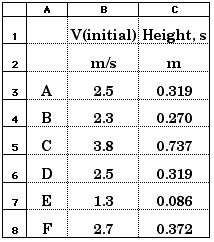
D5.2 Shown in the figure are six laboratory carts of varying masses. Each has an initial velocity and a net force as shown in the figure. Rank these carts on the basis of their final velocity after 10 seconds.






From the mass and the net force we can determine the acceleration;
F = m a a = F/m
Once we know the acceleration, we can readily calculate the velocity from
v = vi + a t and we want to evaluate this for t = 10 seconds.
Again, an AppleWorks spreadsheet seems an easy way to do this same calculation six times:
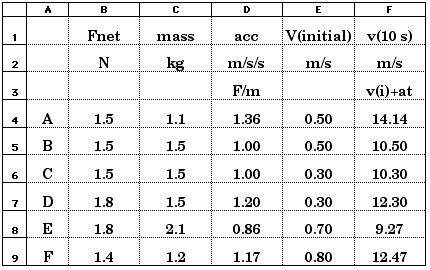
D5.3 The acceleration of gravity on the Moon's surface is about one-eighth what it is on Earth's surface. What is the weight on the Moon of an astronaut whose mass is 85 kg?w = mg w = (85 kg) [(9.8 m/s2)(1/8) ]
w = 104 N
D5.4 A block starts from rest and slides down a frictionless inclined plane that is inclined 20° from the horizontal and is 2.5 meters long. How fast is the block moving as it reaches the bottom?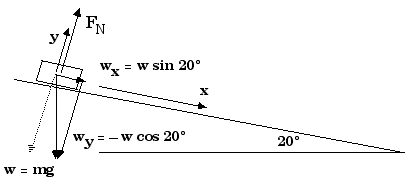
Choose the x-axis to lie along the plane as shown and then the y-axis must be perpendicular to that. The weight is the force of gravity, directed straight down. Notice that the mass of the block is not stated. That means we will include it only as "m" and expect that it "drops out" of our equations at the end.
The normal (or perpendicular) force FN lies in the positive y-direction. We will resolve the weight into its components as shown in the diagram.
wx = w sin 20° = M (9.8 m/s2) (0.34) = 3.35 M(m/s2) wy = - w cos 20° = - M (9.8 m/s2) (0.94) = - 9.21 M(m/s2)
where M is the mass of the block, in kilograms (kg). Now we can apply Newton's Second Law,
Fnet = m a But remember, this is a vector equation and, therefore, is merely shorthand notation for
Now that we know the acceleration it is fairly straightforward to find the velocity when the block has started from rest and moved for a distance of 2.5 m down the plane.
Fnet,x = M ax and Fnet,y = M ay Fnet,x = wx = M ax Fnet,y = FN + wy = M ay wx = 3.35 M(m/s2) = M ax FN - 9.21 M(m/s2) = M ay 3.35 M(m/s2) = M ax FN - 9.21 M(m/s2) = 0 ax = 3.35 m/s2 FN = 9.21 M(m/s2) v2 = vi2 + 2 a ( s - si )
v2 = (0)2 + 2 (3.35 m/s2) ( 2.5 m )
v2 = 16.75 m2/s2
v = 4.1 m/s
D5.5 Four airline baggage carts are coupled as shown in the figure to make a "train"; each has a mass of 250 kg. Find the force F that must be applied to accelerate this "train" at 0.8 m/s2. Find the tension in each of the three couplings between the baggage carts.
There are several approaches to solving this. The following seems the most direct but others may be more instructive.
F is the net force applied to the total mass of
4 x 250 kg = 1000 kg F = m a
F = (1000 kg) ( 0.8 m/s2) = 800 N
FAB is the tension in the coupling between carts A and B.

FAB is the net force applied to the remaining mass of
3 x 250 kg = 750 kg FAB = m a
FAB = (750 kg) ( 0.8 m/s2) = 600 N
FBC is the tension in the coupling between carts B and C.

FBC is the net force applied to the remaining mass of
2 x 250 kg = 500 kg FBC = m a
FBC = (500 kg) ( 0.8 m/s2) = 400 N
FCD is the tension in the coupling between carts C and D.

FCD is the net force applied to the remaining mass of the last cart
1 x 250 kg = 500 kg FCD = m a
FCD = (250 kg) ( 0.8 m/s2) = 200 N
At this point, we are done.
Yet it is instructive to go back and look at all the forces on at least one of the carts. We might look at cart B,

To the right, there is the force on cart B due to cart A; this is FBA. Acting to the left, there is the force on cart B due to cart C; this is FBC. The net force is the vector sum of those two forces,
Fnet = FBA - FBC and we have already solved for those forces.
Fnet = FBA - FBC = 600 N - 400 N = 200 N Of course,
Fnet = m a (250 kg) a = 200 N
a = [(200 N)/(250 kg)] [(kg m/s2)/N]
a = 0.8 m/s2
And, indeed, that is the acceleration we started with. It is important to carefully define what is "the mass" you are looking at in F = m a and then look at all the forces acting on that mass.
D5.6 A 50 ton (50,000 kg) rocket is acted on by an upward thrust of 600 kN. If the rocket is 25 m tall, how long does it require to rise off the launching pad a distance equal to its own height?Always start with a good, clear, detailed free-body diagram:
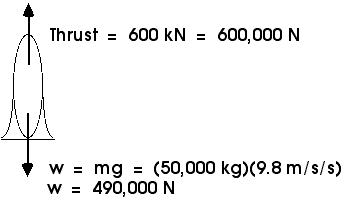
The net force is the vector sum of these forces,
Fnet = 600,000 N - 490,000 N = 110,000 N This net force causes the 50,000 kg rocket to accelerate,
Fnet = m a
a = 2.2 m/s2
Starting from rest, with vi = 0, and having an acceleration of 2.2 m/s2, how long does it take the rocket to move 25 m?
s = si + vi t + (1/2) a t2 25 m = 0 + 0 + (1/2) (2.2 m/s2) t2
t2 = (25/1.1) s2 = 22.7 s2
t = 4.8 s
D5.7 Two small balls of equal mass are connected by a string 1.0 m long and are laid out on a smooth (ie, frictionless) table with one ball (A) just at the edge of the table and the other ball (B) 1.0 m from the edge. The table is 0.5 m high. Ball A is nudged gently over the edge of the table, and things begin to happen.a) How much time is required for ball A to strike the floor?b) How much time is required for ball B to strike the floor?
c) How far from the base of the table does ball B strike the floor?
Good diagrams are always essential and that is certainly true for this situation.
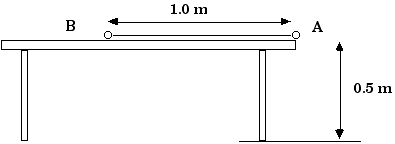
Once ball A goes over the edge, what are the forces on it -- and on ball B? The table edge acts like a pulley, changing the direction of the force exerted by the string.
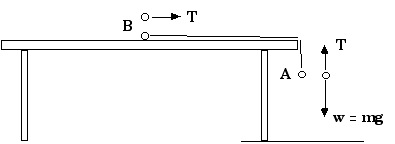
Notice that the masses are not given. We know they are equal and that's all. We will merely put the mass of each ball in the equations as "m" and expect that mass to "drop out" of the equations later on. What is the acceleration of the system? That is, what is the vertical acceleration of mass A or the horizontal acceleration of mass B? Since they are connected by a string, the acceleration of the two balls must be the same. We have the forces from the diagram so we can apply Newton's Second Law, F = m a.
Applied to mass A, that is
Fnet = m g - T = m a That is one equation with two unknowns, tension T and acceleration a. We need an additional equation.
Applied to mass B, that is
Fnet = T = m a We can substitute this back into the equation we found for mass A,
m g - m a = m a 2 m a = m g
a = g / 2 = 4.9 m/s2
The downward acceleration of ball A and the horizontal acceleration of ball B are both 4.9 m/s2.
With this acceleration, how long does it take ball A to strike the floor (remember, it started from rest)?
s = si + vi t + (1/2) a t2 0.5 m = 0 + 0 + (1/2) (4.9 m/s2) t2
t2 = (1/4.9) s2 = 0.204 s2
t = 0.45 s
Call this time tA.
Now, what is going on with ball B?
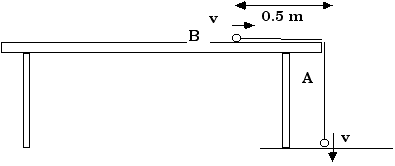
When ball A strikes the floor, ball B has the same speed,
v = vi + a t v = 0 + (4.9 m/s2) (0.45 s)
v = 2.21 m/s
Once ball A strikes the floor, the string will no longer be taut and the tension in the string will be zero so ball B will continue to move 0.5 m to the end of the table with a constant speed of 2.21 m/s. This will require a time of
t1 = v/t = 0.5 m/2.21 m/s = 0.226 s Now we are back to a projectile motion problem,
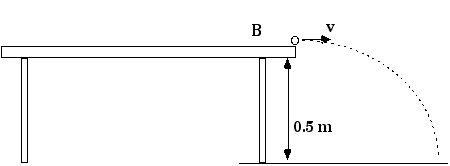
Ball B moves horizontally from the table top with speed v = 2.21 m/s. How long does it take to hit the floor? Moving horizontally simply means the initial velocity in the vertical direction is zero.
y = yi + vyi t + (1/2) ay t2 y = yi + vyi t + (1/2) (- g) t2
0 = 0.5 m + (0) t + (1/2) ( - 9.8 m/s2) t2
4.9 t2 = 0.5 s2
t2 = 0.5 s2/4.9 = 0.102 s2
t = 0.32 s
Let us call this t2; the the total time ttot is
ttot = tA + t1 + t2 ttot = 0.45 s + 0.23 s + 0.32 s
ttot = 1.0 s
c) How far from the base of the table does ball B strike the floor?
During this last 0.32 s, ball B continues to move horizontally with the same horizontal velocity, 2.21 m/s so it travels a horizontal distance of
x = vx t x = (2.21 m/s) (0.32 s)
x = 0.71 m
D5.8 A 7-kg package sits on a rough but level floor. The coefficient of sliding friction between the package and the floor is 0.27. A cord is attached to the package and makes an angle of 30° above the horizontal. What must be the tension in the cord to move the package along the surface with an acceleration of 1.0 m/s2?
We must look at all the forces on the package. That means a carefully drawn free-body diagram.
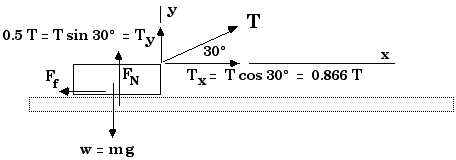
Now we can apply Newton's Second Law -- in its component forms -- to this situation.
Fnet,x = Tx - Ff = m ax = m a 0.866 T - Ff = (7.0 kg) a
0.866 T - Ff = (7.0 kg) (1.0 m/s2)
0.866 T - Ff = 7.0 N
We know the friction force only as
Ff = µ FN = 0.27 FN so we must solve for the normal force FN. We can do this by looking at the y-component of Newton's Second Law,
Fnet,y = Ty + FN - m g = m ay = 0 0.5 T + FN - (7.0 kg)(9.8 m/s2) = 0
0.5 T + FN - 68.6 N = 0
Now we have our required two equations since we have two unknowns (FN as well as T).
0.5 T + FN - 68.6 N = 0 FN = 68.6 N - 0.5 T
0.866 T - 0.27 (68.6 N - 0.5 T) = 7.0 N
0.866 T + 0.135 T = 7.0 N + 18.5 N
T = 25.5 N
D5.9 A man pushes a 20-kg lawn mower at constant speed with a force of 80 N directed along the handle, which makes an angle of 37° with the horizontal. Calculate the following:a) the horizontal and vertical components of the man's force.b) the horizontal retarding force on the mower.
c) the normal force between the mower and the lawn (be sure to include the mower's weight).
d) the effective coefficient of friction in this case.

Fx = 64 N
Fy = - 48 N
(the negative sign meaning "down").
b) If the lawn mower moves at constant speed then the net horizontal force on it must be zero so the horizontal retarding force must be 64 N.
c) The net vertical force is zero,
Fnet,y = FN - m g - 48 N = 0 FN - (20 kg) (9.8 m/s2) - 48 N = 0
FN = 196 N + 48 N
FN = 144 N1/2
d) Ordinarily we describe the friction force in terms of
Ff = µ FN or
µ = Ff / FN If we consider the horizontal retarding force an effective friction force, then this becomes
µ = 64 N / 144 N = 0.44 µ = 0.44
| ToC, Chapter 5 | Course Calendar |
![]()
(c) 2005, Doug Davis; all rights reserved